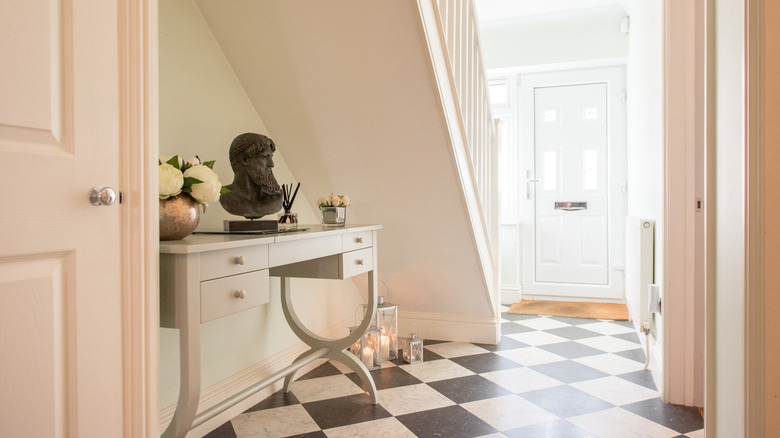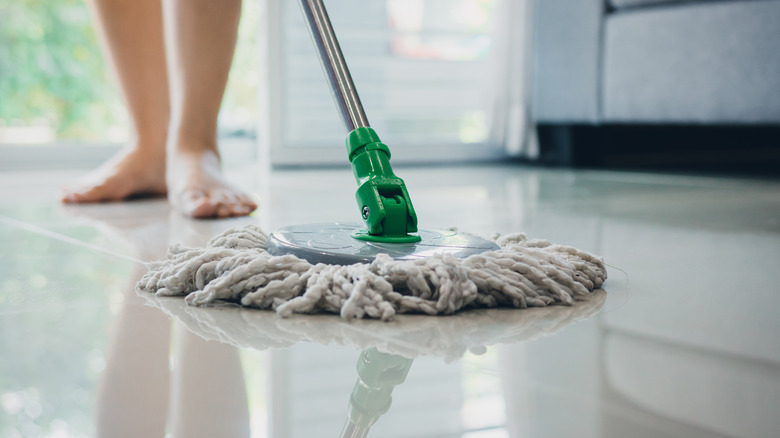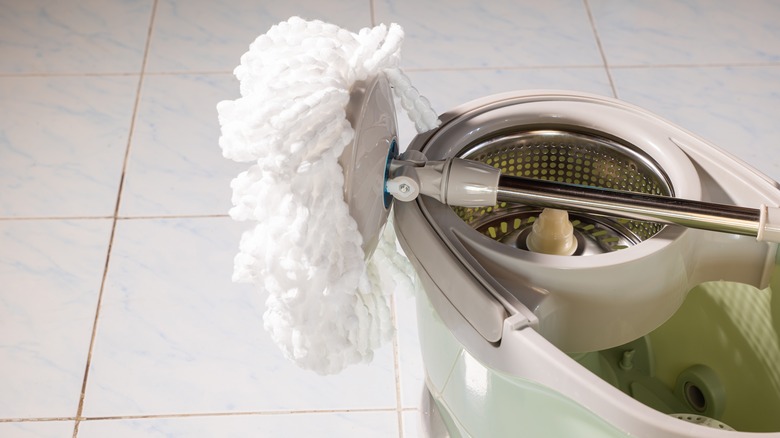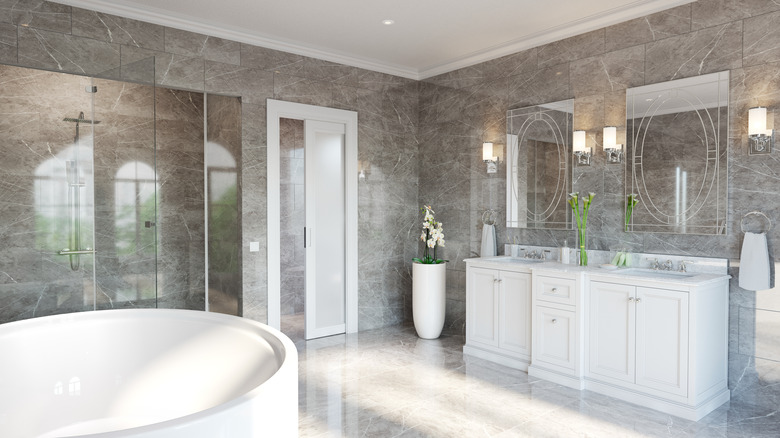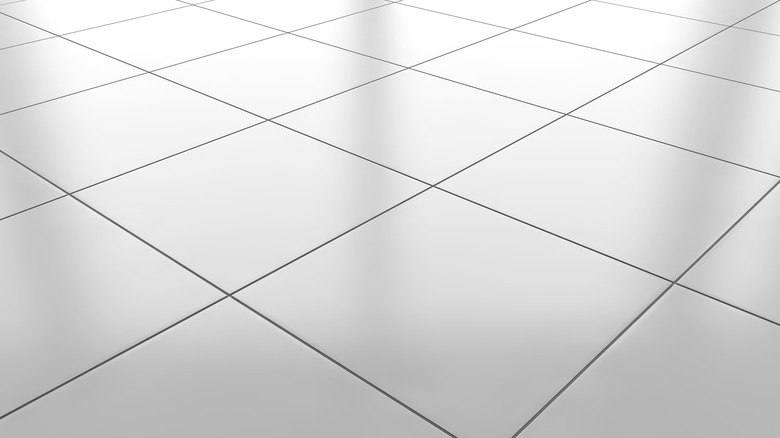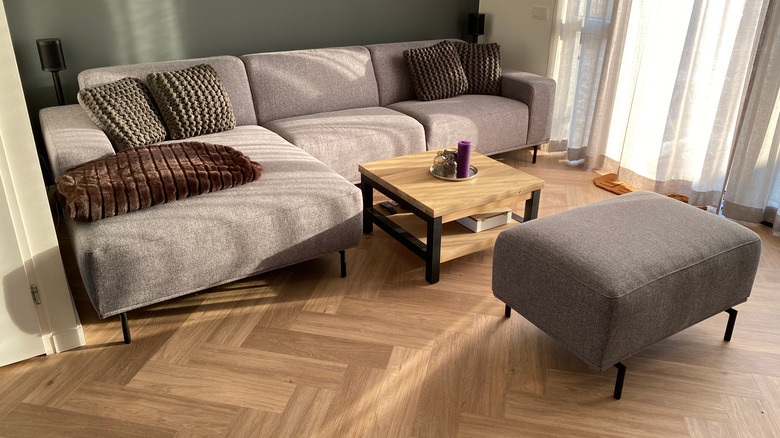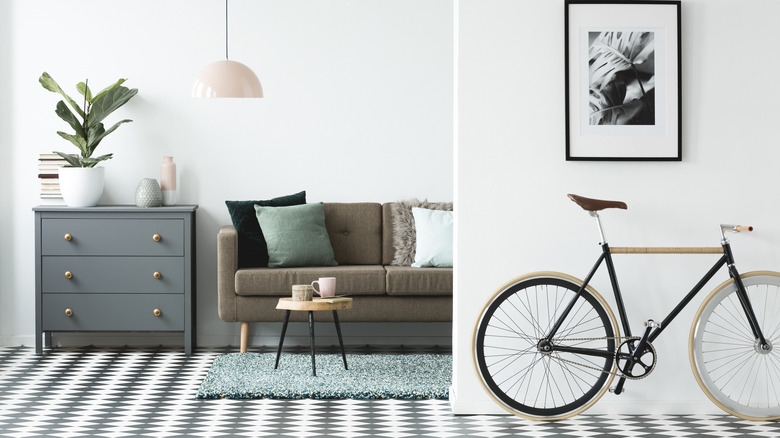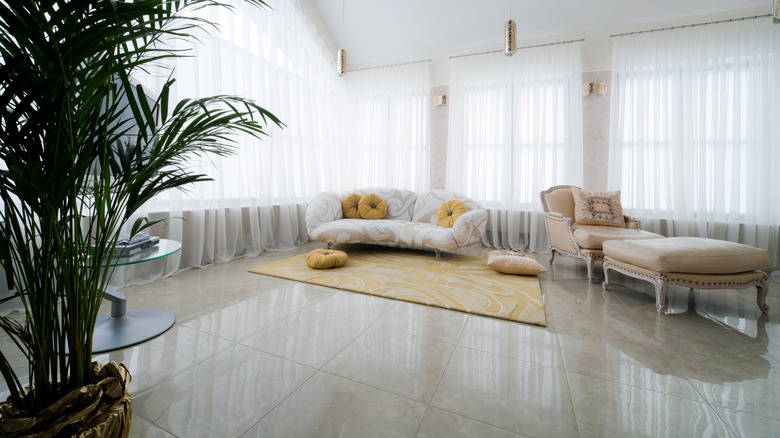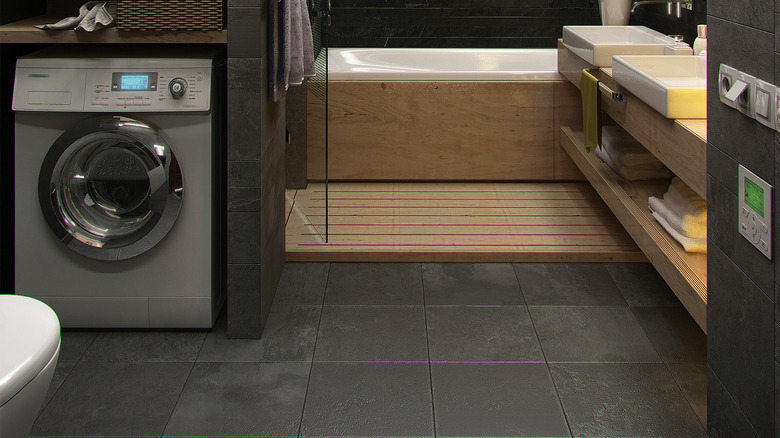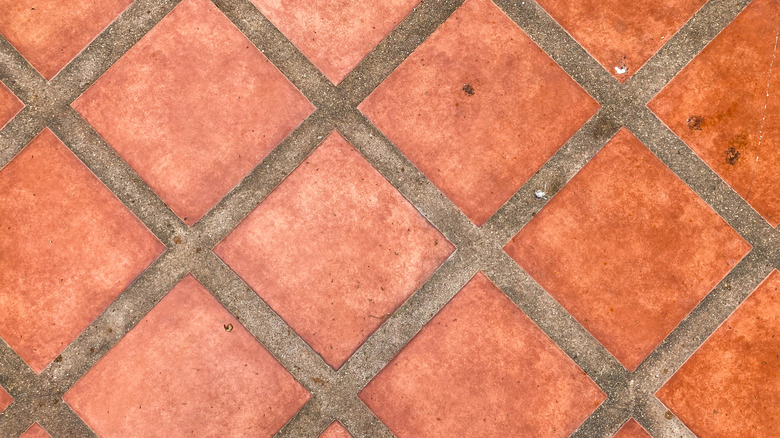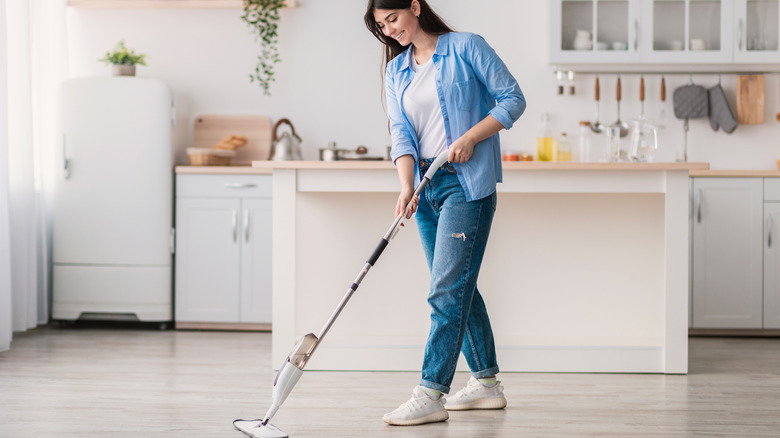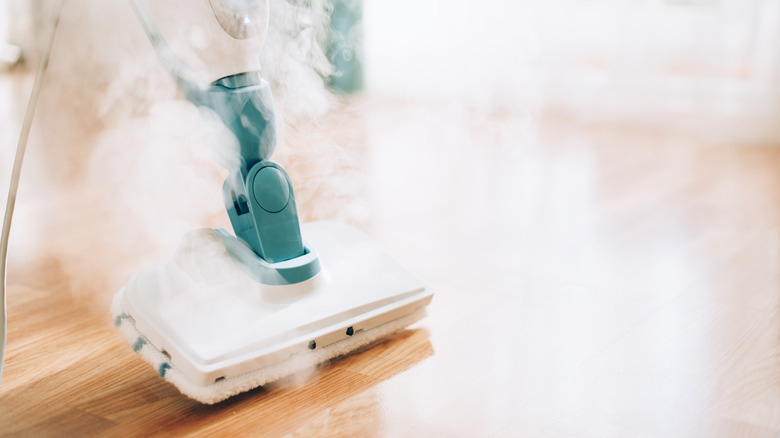How You Really Should Be Cleaning Your Tile Floors
We may receive a commission on purchases made from links.
Tile flooring adds personality and texture to a room, whether it's black and white porcelain checkers in an entryway or luxurious marble tiles in the bathroom. Having said that, not all tile floors are made the same, which means there isn't a one-size-fits-all cleaning method for them. What might be safe for your sturdy ceramic tiles in the laundry room might destroy your slate tiles in the kitchen. And with the expensive cost of materials and labor, no one will want to spend their hard-earned paycheck fixing the mistake. (Or worse yet, living with the damage!)
For the best results, you'll need to know what type of tile you have in your home. This will dictate your choices of cleaning agents, tools, and methods. For example, marble requires cleaning products with a neutral pH balance of 7 or 8, or the tile can be etched. Ceramic tiles, on the other hand, aren't as precious and can be washed with everything from vinegar to soap. Are you worried you might not be taking care of your tile floors properly? Here's how to clean the different options.
Stay ahead of the job by cleaning tile floors on a schedule
You can maintain your tile floors and make life easier on cleaning day by practicing a few daily habits. First of all, it's advisable to sweep or vacuum your tile floor on a daily basis or every two days. This action eliminates the loose dirt, crumbs, and tiny pieces of debris that collect on your floor and build up in the grout. After sweeping or vacuuming, it's a good idea to remove dust and allergens by wiping the floor's surface with a dry, microfiber mop. Additionally, you should immediately wipe up any spills with water, mild detergent, and a soft cloth.
However, even with diligent practice of these daily habits, you'll need to do a more thorough cleaning of your tile floors approximately once every week. Of course, the cleaning schedule of your tile floors is determined, in part, by the number of humans and pets who occupy your home. For example, the kitchen floor in a house with four children, two dogs, and a cat will need more frequent cleaning than a similar tile floor in the home of a single adult with no pets.
Assemble the right equipment for cleaning tile floors
With a few simple pieces of equipment, you'll be ready to make your tile floors gleam. Your first tool should be a broom or vacuum to remove loose dirt, making the next step easier. Then, you'll need a bucket and a wet mop such as the Star Brite chamois mop. Chamois is a material that is more absorbent than microfiber. It's been used for many years to clean and polish multiple surfaces, including automobiles and the decks of boats. However, If you prefer using microfiber as a cleaning material, the O-Cedar microfiber mop is an excellent choice. It's best to avoid using a sponge mop, as it can push the dirt down into the tiles and grout.
Next, you'll need a scrubbing brush with stiff nylon bristles to clean the grout between your floor tiles. The OXO Good Grips deep cleaning brush is ideal for this. Its narrow design and angled handle make it effective and easy to manipulate. Armed with your bucket, mop, and brush, you'll be ready to tackle cleaning your tile floors. Additionally, you may choose to wear protective gloves, such as the reusable Playtex Living gloves, to avoid contact with cleaning agents on your skin.
Tips for cleaning porcelain tile floors
For beauty and durability, porcelain tile floors get high marks. It's hard and durable, making it an ideal tile material in high-traffic areas of your home. It's frequently used in kitchens and bathrooms because it does not absorb water. With a few precautions, you can keep your porcelain tile floors looking like new.
To clean porcelain tiles and the grout around them, you should avoid cleaners that rely on acids or harsh chemicals to break down dirt. These include ammonia, chlorine bleach, and vinegar. Instead, use cleaners with a neutral pH level. The best way to clean porcelain tile is to sweep or vacuum the floor and mop it with a solution of warm water and mild soap, such as mild dish detergent. After mopping with the soap solution, rinse the mop and prepare a bucket of clear water. Mop the floor again with the clear water. Finally, dry the floor with an old towel to bring out its shine.
Best ways to clean ceramic tile floors
Ceramic tile floors last for years, but you'll want to avoid scratches and discoloration by using the best cleaning methods. This type of tile is softer than porcelain and more prone to show scratches on the surface. For this reason, it's important to sweep, vacuum, or dry mop your ceramic tile floors regularly. Otherwise, normal foot traffic causes small pieces of dirt and debris to grind into the ceramic surface, leaving behind permanent scratch marks.
Mop your ceramic tile flooring with a bucket full of hot water in which you dissolve ½ cup of vinegar and ½ teaspoon of liquid dish detergent. To clean the grout, you can make a paste of ½ cup of baking soda, ¼ cup of hydrogen peroxide, and 1 teaspoon of liquid dish soap. Use your nylon-bristle brush to scrub the grout with this paste. Rinse the floor with clear water, and dry it with a towel. Don't use bleach, abrasive materials, and oil-based cleaners on ceramic tiles.
Follow these suggestions for cleaning vinyl tile floors
Vinyl flooring is popular among homeowners due to its durability, attractiveness, and economical pricing. In recent years, manufacturers have developed luxury vinyl plank flooring that mimics the look of hardwood floors as well as luxury vinyl tile flooring, a ceramic tile look-alike. Many people clean vinyl tile floors with commercially prepared vinyl cleaners. Packaged in a spray bottle, you can spray the cleaner directly onto the floor and wipe it immediately with a dry microfiber mop. Be sure to use a cleaner specially formulated for vinyl floors, such as Bona Pro Series or Rejuvenate.
To remove dirt and debris that might scratch your vinyl floors, sweep or vacuum them every day or two and wet-mop them every one-to-two weeks. If you prefer not to use a commercial cleaning product, mix your DIY solution for vinyl tile floors. Mixing 1 cup of apple cider or white vinegar with 1 gallon of warm water is a simple cleaner for wet mopping. To avoid damaging the topcoat of the vinyl material, don't use stiff brushes or abrasive materials on vinyl tile flooring. Additionally, you should refrain from using cleaners that contain ammonia or bleach, as the chemicals in those cleaners can damage the vinyl.
Clean your linoleum tile floors with these common household products
Using a few simple products that you probably have around the house, you can clean linoleum tile floors and make them shine. First, sweep or vacuum the floor to remove all loose dirt. Then, mix 1 tablespoon of liquid dishwashing soap in 1 gallon of warm water. Alternatively, you can mix 4 cups of white vinegar with 4 cups of warm water. Add a few drops of essential oils, such as lavender or lemon oil, for a fresh scent. Mop your floor with the DIY solution of your choice and complete the job by drying the surface with an old towel.
After you've cleaned your linoleum tile floor, you'll want to add one more step to restore its shine. Mix 5 drops of baby oil with 1 cup of white vinegar in a bucket full of hot water. Damp-mop your floor with this solution and allow it to air dry. Your linoleum tile will dry to a beautiful shine.
Cleaning methods for marble and granite tile floors
You can preserve the natural elegance of marble and granite tile floors by taking simple precautions with cleaning products. Natural stone floors are susceptible to scratches and corrosion. Therefore, it's important to keep acidic substances away from them. Avoid cleaning products that contain vinegar or lemon. Instead, use cleaners with a low-to-mild pH level. Choose a commercially prepared cleaner that is designated for natural stone flooring. Or, for a DIY approach, you can use mild dishwashing soap that is well diluted with water. Alternatively, a highly diluted mixture of ammonia and water safely cleans natural stone tile floors. Add no more than 1/2 cup of ammonia to 1 gallon of warm water for damp-mopping. Be sure to dry the floor with a towel after damp-mopping to remove any residue from cleaners.
It's crucial to avoid abrasive tools and substances on natural stone floors. Instead of scrub brushes and cleansing powders, use soft cloths and mops made from chamois or microfiber materials. Granite and marble floors should be sealed periodically to protect their beauty. You'll know when it's time to reseal your natural stone tile floor when water does not bead up on its surface.
Maintain the beauty of slate tile floors with these cleaning tips
Slate is a durable, natural stone that provides style and functionality when used in flooring tiles. Like other natural stone tile products, slate is susceptible to scratches and stains. Keep it clean with regular sweeping or dry mopping with a soft mop. When you vacuum a slate tile floor, don't activate the beater brush, as it could scratch the slate. When it's time for the weekly damp-mopping job, avoid acidic cleaners that contain lemon, vinegar, or bleach. Additionally, you should banish ammonia, abrasive powders, and oil-based cleaners from your arsenal of cleaners for slate floors. The best cleaner for slate tiles is mild dish detergent that is well-diluted in a bucket of warm water. Be sure to wipe the floor with a dry towel after damp-mopping.
Slate tile floors should be sealed periodically to maintain water resistance and to prevent stains from food and drink spills. Don't use regular floor wax to seal slate. Instead, use a specially formulated, commercial slate sealer. With regular sweeping and cleaning, as well as appropriate sealing, slate tile floors can last for decades.
Best ways to care for quarry tile floors
Quarry tiles use natural materials sourced from the earth, including shale, clay, and feldspar. They are durable and slip-resistant when wet, making quarry tiles an excellent choice for high-traffic areas in the home as well as outdoor living spaces. Quarry tiles must be sealed when installed to prevent stains and discoloration. With proper cleaning methods, these floors can last for decades.
On a daily basis, vacuum your quarry tile floors to keep them free of loose dirt. This is the preferred cleaning method, as sweeping can push the dirt into the grout joints. When it's time for wet mopping, choose a multi-purpose, alkaline cleaner without harsh chemicals, or simply use mild detergent dissolved in a bucket of warm water. The best tool to clean quarry tiles and their grout joints is a tail-band or looped-end string mop. This type of mop lifts the dirt out of the grout and cleans the tiles' surfaces. Dry the floor with a towel after wet mopping. Occasionally, you'll want to clean the grout joints between the tiles with a stiff-bristle brush to keep it looking like new.
Save time and energy by using a spray mop on your tile floors
If the idea of wielding a bucket and wet mop makes you dread cleaning day, you might want to use a commercially formulated cleaning solution that you apply via a spray mop. Viable choices include the Rubbermaid Reveal spray floor mop, the O-Cedar Pro Mist spray mop, the Swiffer Wet Jet, and the Bona premium spray mop. The downside of this cleaning method is that it's more expensive than wet-mopping with a homemade solution, but it certainly makes the floor-cleaning job easier and faster.
Sweep or vacuum your tile floors to remove loose dirt before cleaning them with a spray mop. Then, simply spray and mop throughout the entire area. Pay attention to the mop pad, and change it when it gets dirty. A dirty mop pad can spread dirt over the floor rather than remove it. While this is a convenient option for most tile floors, you can't use it on each one. Avoid using spray mops on marble. Most dry mop solutions, like Swiffer Wet Jet's, have a pH of 10, making them alkaline. Marble must be treated with neutral cleaners with pH levels of 6 or 8. You also don't want to use it on unsealed tile, as the solution can stain it.
For extra thorough cleaning, try steam-cleaning your tile floors
Occasionally, you might want to do a deep-cleaning job on your tile floors. Steam cleaning is an excellent method to achieve deep-clean results on flooring made from ceramic, porcelain, and slate tiles. If your tile floors are made from these materials, you might want to purchase the Bissel power steam mop, or the Shark steam pocket mop, or the PurSteam mop. Be aware that steam cleaning is not appropriate for vinyl, marble, and granite tile floors.
Follow the manufacturer's instructions to operate a steam mop. The hot steam not only cleans dirt and grime from tile floors but also sanitizes surfaces by killing bacteria. Additionally, steam mops clean the grout joints as well as the tiles. Change the mop head when it becomes dirty to avoid spreading dirt over the floor.
By understanding a few precautionary principles, you can use the appropriate cleaning products and methods to keep your tile floors in excellent condition. With the best cleaning procedures, your tile floors will provide years of attractive appearance and durable service.
